

| Trade log-in: | HERE | |
| Get password | Forgot password | ||

2015.3 | 2015.2 | 2015.1
2014.3 | 2014.2 | 2014.1 | 2013.3 | 2013.2 | 2013.1 | 2012.3 | 2012.2 | 2012.1
2011.3 | 2011.2 | 2011.1 | 2010.3 | 2010.2 | 2010.1 | 2009.3 | 2009.2 | 2009.1
2008.3 | 2008.2 | 2008.1 | 2007.3 | 2007.2 | 2007.1 | 2006.3 | 2006.2 | 2006.1
2005 | 2004 | 2003 | 2002 | 2001 | 2000
This month we mourn the shocking death of our friend Campbell Bridges.
The Gemological Institute of America continues its rotating exhibit, “Facets of GIA,” which includes amongst 130-plus pieces, the emerald and diamond aigrette pictured below. The items displayed are rotated on a regular basis.
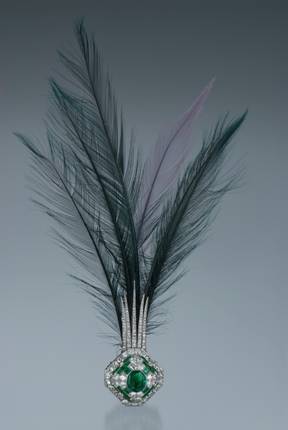 |
| Emerald and diamond aigrette set in platinum and adorned with feathers, was made by Cartier circa 1925. Courtesy of a private collector. (Photos © GIA) |
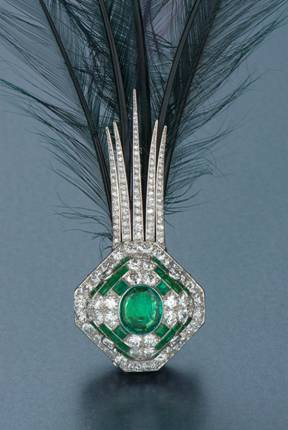 |
Objects displayed include “gem crystals, gemstones, gem art objects, jewelry, equipment and books,” according to a GIA news release. The exhibit is mounted on the GIA’s world headquarters in Carlsbad, California, until May 2010. Also featured in the exhibit are the blue and yellow Sri Lankan sapphire crystals from the collection of Bill Larson. [back to top]
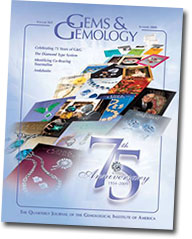 |
| (Image © GIA) |
As Pala International celebrates its 40th year we should mention here that GIA’s Gems & Gemology has published its 75th anniversary issue. (The two articles discussing G&G’s years of service are available for free download.) The journal’s pages aren’t limited to self-congratulation, of course, with an article like “Spectral Differentiation Between Copper and Iron Colorants in Gem Tourmalines” by Paul B. Merkel and Christopher M. Breeding.
Congratulations—and many more! [back to top]
This month we feature a stunning suite of chrysocolla from the Globe Hills of Arizona. This neon-blue gem silica is reminiscent of a paraiba color due in part once again to the presence of copper. These stones feature a beautiful, even Caribbean-blue color with a few subtle clear veins running through the material. Cabochons were cut from same piece of rough so the 11-piece set has uniform color and sets up nicely for a necklace layout.
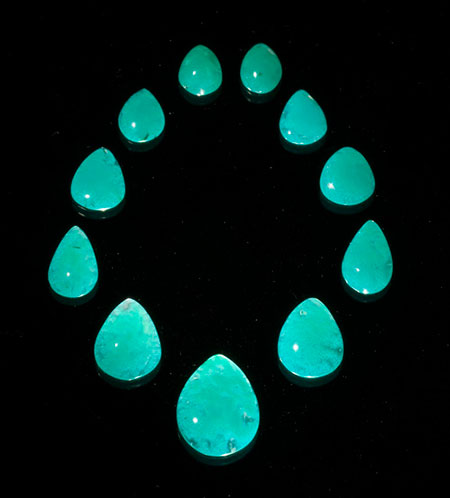 |
| Gem chrysocolla suite, 11 pieces with a total weight of 34.68 carats, ranging in size from 11 x 8 to 15 x 21 mm. Inventory #17488. (Photo: Jason Stephenson) |
The suite was carved by San Diego artist Bud Standley, who now has a studio in Balboa Park’s Spanish Village Art Center.
Below is a piece of rough chrysocolla, also from the Globe district in Arizona, displaying the electric blue hue and a layer of druse covering some of the botryoidal formations.
 |
| Rough chrysocolla specimen, 4.6 x 3.6 x 2.1 cm. Inventory #17401. (Photo: John McLean) |
Interested? Select the inventory numbers above, call, or email us to inquire. [back to top]
Last month, a staff member of SSEF Swiss Gemmological Institute visited Pala International in Fallbrook. During the course of the visit, Pala’s Bill Larson donated a collection of rare gemstones, including painite, johachidolite, boleite, herderite, serendebite, and Mexican andradite. The stones will be used by SSEF in research and education.
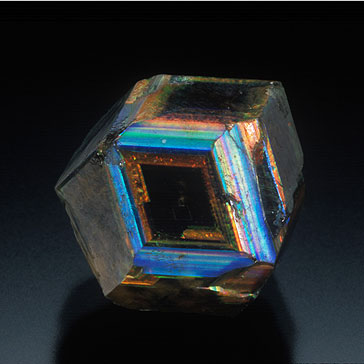 |
| Although this is not the actual stone donated, it is a nice example of the type of unusual and rare Mexican andradite included in the parcel of rough and cut goodies gifted to SSEF. 1.1 cm. wide, Sonora. From the collection of Bill Larson. For some other photos from the donation, see this SSEF press release. (Photo: Jeff Scovil) |
Regarding the gift, Larson remarked, “We have really good relations with all the labs and love when possible to help donate known-locality rough for study.” SSEF singled out Pala’s Gabrièl Mattice for her role in completing the donation transaction. [back to top]
A jeweler recently sent us an emerald that was accidentally zapped with a laser welder during a repair job. We decided to take some close-up shots for the craftsman who works with these types of devices.
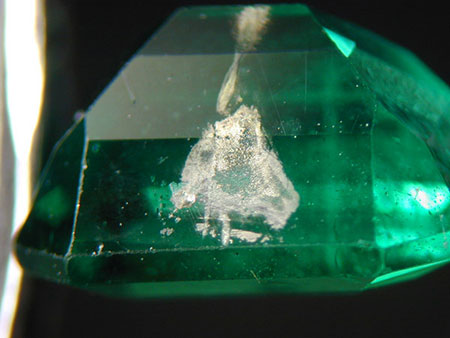 |
| I hate when that happens… Scarring is painfully evident after the encounter with a laser welder. (Photos: Jason Stephenson) |
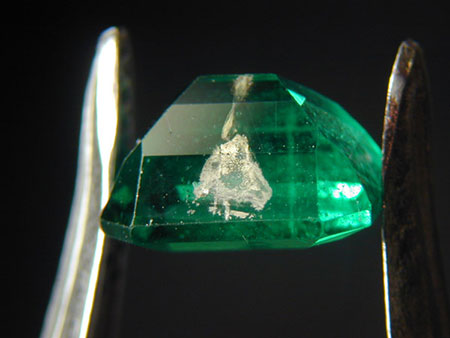 |
The surface of the emerald has clearly been burned by the laser. You can actually feel an indentation where the surface has been scarred. The burn just penetrated the surface and ultimately was simply re-polished with slight weight loss. Whew! [back to top]
“I think overall it is an important time to report the price strength of emeralds.” Thus declares Stuart Robinson, gemstone editor of Gem Market News, in a new article by emerald dealer and author Ronald Ringsrud. Ringsrud discusses why now may be the time to procrastinate no more in trading a little green for green.
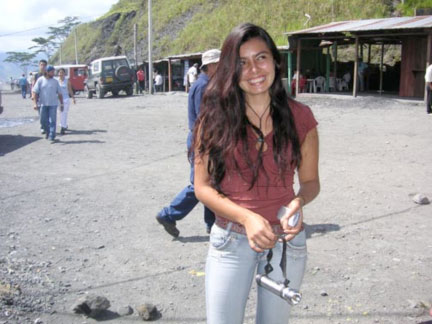 |
| Joanna Campos, an emerald miner from the Coscuez mine in the Muzo Region of Colombia, is pictured here holding her miner’s flashlight. The black inner-tube rubber is for attaching it to the hard-hat. Emerald production in the region went down with the global recession but remains steady, reflecting a constant demand. (Photo: Ronald Ringsrud) |
Ringsrud also quotes fellow dealer Eileen Weatherby, who talks about emerald’s ability to withstand the volatility of the gemstone marketplace. [back to top]
In our August Mineral News, we included other comments by Ringsrud regarding the move from GIA to the Bowers Museum of “El Itoco,” the 1 x 4-inch, 472-carat emerald crystal unearthed a year ago this month. The crystal will be displayed beginning September 12 for six weeks only in conjunction with the retrospective of Colombian artist Fernando Botero. [back to top]
 |
| Take a dip in this tranquil pool. The complexity of a fine emerald, even in a smaller size, is nonetheless compelling, as seen in this 1.97-carat Colombian stone. Inventory #15527. (Photo: Wimon Manorotkul) |
All of us here at Pala International as well as the entire gemological community are shocked and devastated by the senseless murder of Campbell Bridges in Kenya last Tuesday. We offer our sincere condolences to the Bridges family and to let them know that Campbell will always have a special place in all of our hearts. We have lost a true legend of our industry and legends are not easily replaced. We all lost a piece of our gemological spirit on Tuesday, but we also know that he will continue to live on in all of us.
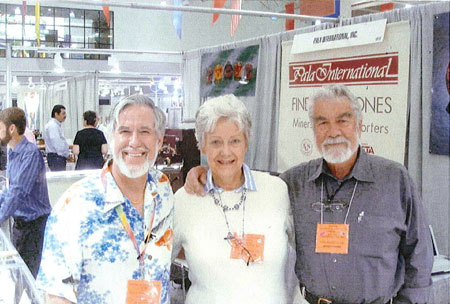 |
| At the 2009 AGTA GemFair, Tucson. Judith and Campbell Bridges, with Pala’s Josh Hall at left. (Photo: Bruce Bridges) |
Campbell was a long-time friend of Pala Internationals. Bill Larson remembers: “I met with him often in Nairobi in the 1970s to 1990s. He showed me the first fine spinel crystal recovered from the now famous Mahenge deposit.. I also met him in Nairobi once after he walked back some 60 kilometers through the bush after crashing his small plane—and survived.”
Forty-two years ago in Tanzania, Campbell Bridges discovered the green variety of grossular garnet that he and Tiffany’s Henry Platt would dub tsavorite, after Kenya’s Tsavo National Park, near deposits of the gem in Taita-Taveta. (We most recently reported on this district in conjunction with a new find of color-chang garnet.) Bridges’s license to mine in the area he helped make famous was upheld as late as last month, according to his son Bruce, as reported August 12 by the the Telegraph (UK). Nevertheless, Bridges had been receiving death threats, and withstood three years of moves by “powerful local figures” to get him off his claim. The attackers were known to Bruce, and the day after the murder, six men were detained by Kenyan police, according to a second Telegraph story.
The life and death of Campbell Bridges are the subject of an August 13 report in The Times (London). Bruce Bridges is interviewed the same day in this BBC video stream.
Campbell is survived by his wife Judith, his son Bruce, and his daughter Laura. Condolences may be sent to gems@tsavorite.com. A public funeral service will be held at noon on Friday, August 21, at All Saints Cathedral in Nairobi. Susie Kennedy, the International Colored Gemstone Association Ambassador to Kenya, will deliver a eulogy. [back to top]
A ban on Madagascar mineral product exports—imposed following the display of a 536-kg emerald-on-matrix specimen last year—has been lifted as of July 17, as stated in a press release issued August 14 by Tom Cushman, International Colored Gemstone Association Ambassador to Madagascar. Bloomberg reported the same day that gemstone exporting had begun July 31, with 10–15 shipments having left the country by August 13, according to Nadine Ranorosa, Secretary General of the Ministry of Energy and Mines.
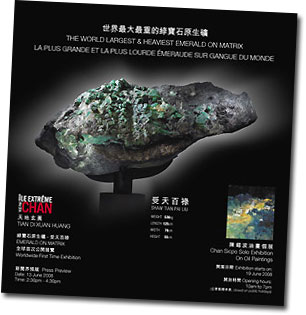 |
| Display abroad in early 2008 of a massive emerald specimen is blamed for triggering the export ban when then-president Marc Ravalomanana believed a national treasure had slipped away. The specimen is shown above in a poster for a later exhibition held in Hong Kong with artist Chan Sicpo, who likened the specimen to its first exhibition venue, Réunion island, a French département. Detailed photos from the Hong Kong show are on Mindat. (Image courtesy Baoqu Tang Modern Art Gallery) |
Gary Roskin, also on August 14, issued a report on the situation, including details about the ban, its effect on the country’s business, and prospects for the future. [back to top]
 |
| No need to splurge to celebrate the banished ban. This 3.81-carat natural Madagascan tourmaline is cushion cut and cushy on the budget. Inventory #17341. (Photo: Mia Dixon) |
 |
| This rare bastnaesite from Pakistan features excellent brilliancy. Inventory #12870. (Photo: Mia Dixon) |
Gemstone exports during Pakistan’s 2008–2009 fiscal year (July–June) show a dramatic drop, according to provisional figures released July 28 by the country’s Trade Development Authority. While jewelry exports increased by over 35 percent in value, gemstone exports fell more than 54 percent. Jewelry ($288 million), in fact, accounts for 84 times the value of exported gemstones ($3.4 million). The average unit price (AUP) for gemstones dipped slightly, whereas the AUP for jewelry doubled.
The gemstone export statistics are in contrast with provisional figures for 2007–2008, which had shown a 35 percent increase in value over 2006–2007. (See our 2008 report.)
Gemstones account for only .02 percent of Pakistan’s total exports (down from .05 last year), and jewelry is 1.62 percent (up from last year’s 1.24).
Compared with Burma’s gem and jewelry exports of $647 million for 4/07–3/08 (the most recent figures available), Pakistan’s total is still a little more than a third as large, at $221 million. [back to top]
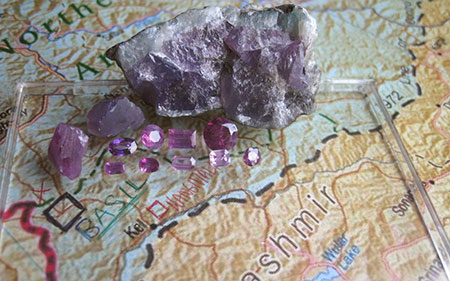 |
| Gemological Institute of America Laboratory Bangkok tested “unusual purple sapphires” from the Pakistan-controlled Kashmir area in April. The stones are thought to have been mined near the villages of Batakundi and Basil (see map above in this photo by Vincent Pardieu, one of the report’s authors). You can read the full report at the lab’s website. (Photo: Vincent Pardieu, Fieldgemology.org) |
In the summer of 1996, Richard Hughes visited with his family the famously played-out borderland ruby mining area of Chanthaburi in eastern Thailand, determined to follow the miners further afield to clandestine mines, foiled only by Thailand’s armed special forces who acknowledged the fact of mining, but had other reasons for keeping the travelers out of the area.
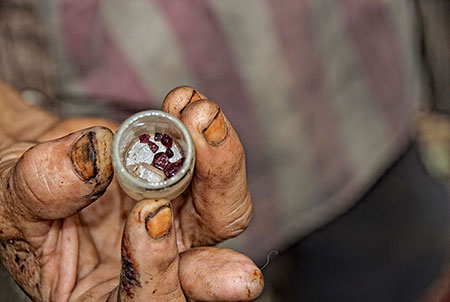 |
| A handful of rubies, along with a piece of quartz from Thailand’s last ruby miners. (Photo © Richard W. Hughes, April 2009) |
With Thailand as his home once more as of last fall, Hughes and pal Vincent Pardieu (also based in Bangkok) journeyed to the Cambodian side in February. But, as Hughes playfully puts it, “No one alive has visited as many ruby and sapphire mines as Vince. And yet on the way back to Thailand from Pailin [in Cambodia], I realized this poor boy had so much dew around his ears that he’d never actually witnessed a ruby being mined in Thailand.” Returning to Chanthaburi as their starting place, Hughes retraced steps taken years ago, this time with Pardieu. And this time they were waved through the army checkpoint.
Read “Red Sky at Dusk: Hunting the Last Siamese Ruby Miner.” [back to top]
President Barack Obama signed into law a reauthorization of sanctions against Burma on July 28, as reported by National Jeweler, “dashing the hopes” of several trade organizations that had urged Congress to reconsider.
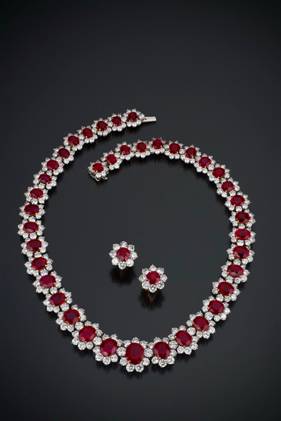 |
| This ruby and diamond necklace, on display in “Facets of GIA,” contains 39 unheated Burmese rubies set with 302 diamonds. The image below shows the necklace and earrings fluorescing under ultra-violet light. Courtesy of Mona Lee Nesseth, Custom Estate Jewels, and a private collector. (Photos © GIA) |
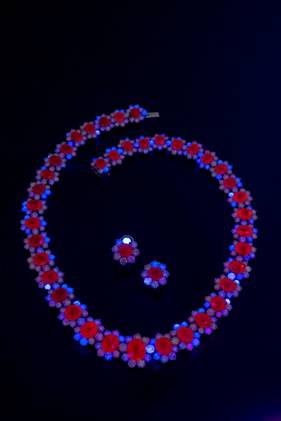 |
The signing was done quietly, with but a two-line statement coming from the White House. The signing was in contrast to last year’s signing, complete with photo op. Admittedly, Obama has bigger fish to fry, but the relative silence may indicate a certain ambivalence on the part of the executive branch. [back to top]
Last month we reported on a devastating landslide in the jade mining area of Hpakant.
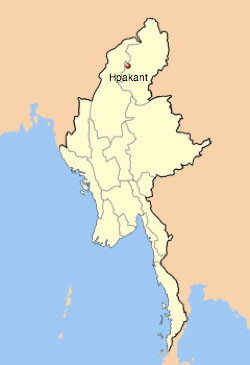 |
| (Map courtesy Wikipedia) |
Here are some reports that have been posted since our last Gem News July 16:
 |
| Hot. This heated pink sapphire from Burma comes with an AGL fast-track cert and a beautiful cut. Inventory #15669. (Photo: Mia Dixon) |
[back to top]
— End August Newsletter • Published 8/19/09 —
All of us here at Pala International as well as the entire gemological community are shocked and devastated by the senseless murder of Campbell Bridges in Kenya on Tuesday. We offer our sincere condolences to the Bridges family and to let them know that Campbell will always have a special place in all of our hearts. We have lost a true legend of our industry and legends are not easily replaced. We all lost a piece of our gemological spirit on Tuesday, but we also know that he will continue to live on in all of us.
 |
| At the AGTA GemFair, Tucson. Judith and Campbell Bridges, with Pala’s Josh Hall at left. (Photo: Bruce Bridges) |
Campbell was a long-time friend of Pala Internationals. Bill Larson remembers: “I met with him often in Nairobi in the 1970s to 1990s. He showed me the first fine spinel crystal recovered from the now famous Mahenge deposit.. I also met him in Nairobi once after he walked back some 60 kilometers through the bush after crashing his small plane—and survived.”
Following is the ICA announcement.
New York, NY – August 11, 2009 – The International Colored Gemstone Association (ICA) received a report that an unidentified mob in Kenya attacked legendary Scottish geologist and ICA Director Campbell Bridges, his son Bruce and other parties over an unknown dispute at a mine in the Taita Taveta District in Tsavo National Park.
At this time reports indicate that Campbell did not survive the attack; the extent of Bruce Bridges’ injuries is unknown at this time. Campbell’s body arrived in Nairobi a few hours ago accompanied by Bruce.
Susie Kennedy, ICA Ambassador to Kenya, and other ICA members are sending updates to ICA Headquarters in New York as they happen. Further details will be reported as they are received.
We are informed that Campbell’s son, Bruce, was released from hospital as of today. Campbell is survived by his wife Judith, his son Bruce, and his daughter Laura. We are requested to respect the family’s privacy and minimize phone calls and emails until further notice. Condolences may be sent to gems@tsavorite.com. Several news reports of Campbell Bridges’s death have appeared:
[back to top]
 |
Pala International heads to the East Coast later this month for the trade-only JA New York Summer Show. Stop by to see one of America’s largest selections of fine colored gems.
When: July 26–July 29, 2009
Where: Jacob K. Javits Convention Center
Hours: AGTA Gemstone Section
Sunday, July 26: 9:30 AM – 6:00 PM
Monday, July 27: 10:00 AM – 6:00 PM
Tuesday, July 28: 10:00 AM – 6:00 PM
Wednesday, July 29: 10:00 AM – 3:00 PM
Pala International is in booth 1361. See the JANY website for more information. Visit the Pala International Show Schedule for future events. [back to top]
This month we feature an exquisite new demantoid garnet from Russia. This 3.51-carat jewel has a succulent green hue, medium tone, and full saturation. Inside, we find a fine example of the diagnostic horsetail inclusion.
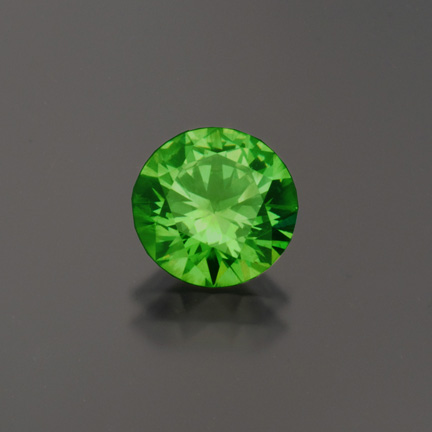 |
| Russian demantoid garnet, above, 3.51 carats, dimensions 9.38 x 5.8 mm. Below, the same demantoid under different lighting conditions, bringing out the phenomenal dispersion from within. (Photos: Above, Mia Dixon; Below, Jason Stephenson) |
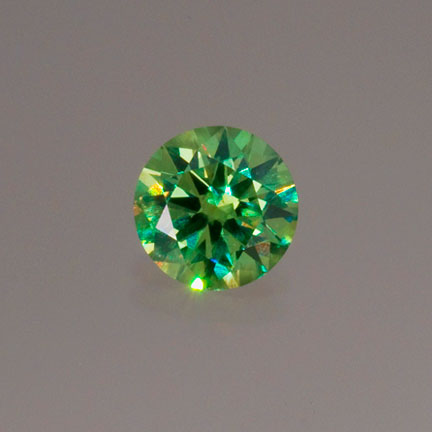 |
Recent mining ventures in Russia have begun to produce new demantoid garnet material. Pala is once again involved with distribution and we have a fine selection to offer. Extremely saturated greens in all shapes and sizes, many with superb examples of horsetails and some other intriguing inclusions.
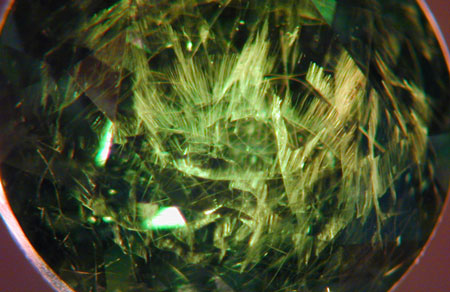 |
| Aurora adamantis. The aurora-like inclusions above are actually interwoven bands of horsetails. This is from a 2.33-carat round, 7.3 x 5.0 mm. (not from our featured gemstone). (Photomicrograph: Jason Stephenson) |
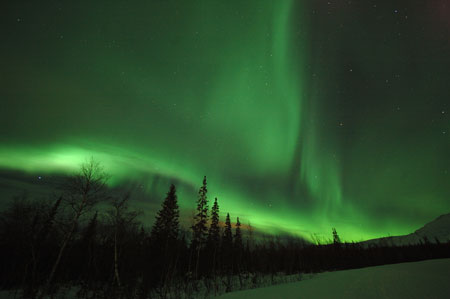 |
Some of these quiescent internal formations seem to resemble other active formations on a grander scale. The radiating horsetail spray with a definable core resembles an exploding firework. The interwoven bands of horsetails are reminiscent of the liquidity and beauty of the aurora borealis.
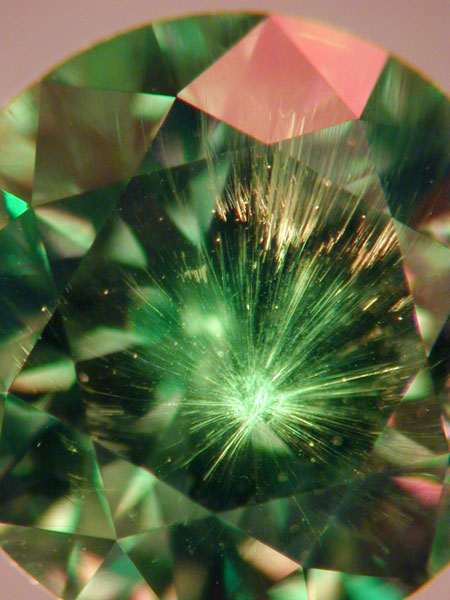 |
| Pow! An inclusion mimics a firework spray. From a 1.21-carat round, 6.0 x 4.0 mm. (Photomicrograph: Jason Stephenson) |
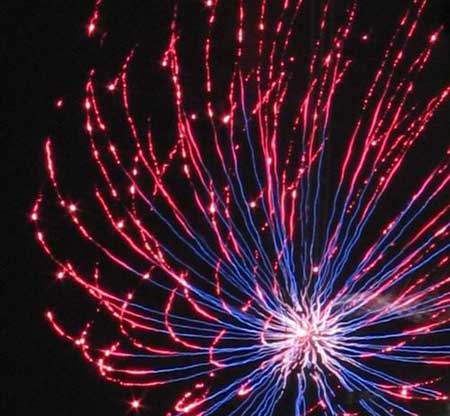 |
These micro to macro associations gives us a little insight into the complex dynamics that are at work during crystallization of these demantoid garnets. Heat, pressure, and chemistry meet in a unique situation in time and space. Beauty is found on many scales.
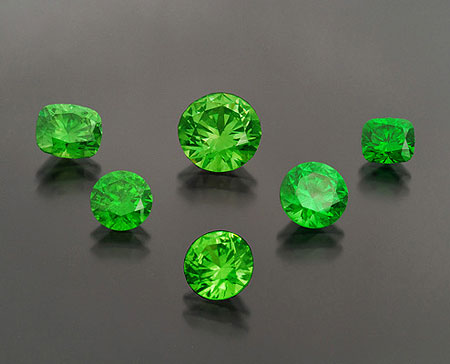 |
| Suite of Russian demantoid garnet, (clockwise from left) 1.97 carats, 7.46 x 6.25 mm.; 3.51 carats, 9.38 x 9.38 mm.; 1.15 carats, 6.07 x 5.44 mm.; 1.28 carats, 6.68 x 6.68 mm.; 1.98 carats, 7.41 x 7.41 mm.; 1.73 carats, 7.23 x 7.23 mm. (Photo: Mia Dixon) |
Interested? Call or email us to inquire.
See this new page on Palagems.com:
For other information on demantoid garnet:
[back to top]
This report, dated May 6, comes to us from Raja Shah, a fellow member of the International Colored Gemstone Association.
The New Year brought a new discovery to the Taita-Taveta area of Kenya: color-change garnet. This mining area is known for the vast majority of tsavorite production in East Africa and also produces other gems including ruby, golden and chrome tourmaline, red garnet, apatite, etc.
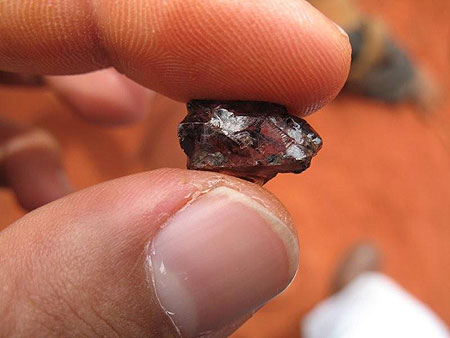 |
| Masquer. Because of the color-change properties of this Kenyan material it originally was thought to be alexandrite. Read and see more here. (Photo courtesy Raja Shah) |
While digging a pit latrine in early January, a ranch hand came across some unusual looking stones just a few feet below the surface and showed them to one of the local gem brokers. What followed is the classic tale of mining rushes.
Read the full story about these color-change garnets on Palagems.com.
Interested? Pala can help you find the ideal color-change garnet for your collection or your client. Give us a call or email us for more information.
See more on color-change garnet in the inaugural issue of The Roskin Gem News Report. [back to top]
Some research reports of note from recent weeks…
 |
GIA Research (Thailand)’s “Beryllium Treated Blue Sapphires”: This status report covers old ground and new, including examination of two large blue sapphires, 22.52 and 55.88 carats. The latter was submitted by the owner who had treated the stone himself, leading to a visit to his facility.
GIA Research (Thailand)’s “Potential for Diffusing Copper into Tourmaline”: A status report on a what-if study from a perspective of researchers having not yet observed copper diffusion in Mozambique tourmaline. The experiments are being undertaken by John L. Emmet.
Continuing the theme, GIT-GTL’s “Heating Experiment of Copper-Bearing Tourmaline,” which discusses growth tubes that transform from yellow-brown to brownish red, post-treatment.
And finally, because we can’t resist a name game… Australian Gemmologist’s Grahame Brown Memorial Issue – Part Two includes appraiser–author Richard Cartier’s “Optical Phenomena in Gemstones,” which discusses
phenomena that may be described as a type of sheen. Much of the literature offers differing and sometimes conflicting uses of terms, and the following definitions and explanations are this author’s attempt to rationalize them.
[back to top]
The recent special gem sale, held in Yangon June 22 through July 4, earned €209 million ($292 million) on the sale of jade, according to an Associated Press source. The July 7 AP story reported that nearly 5,500 jade lots were sold via bidding.
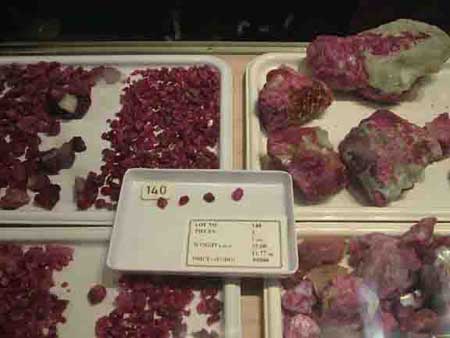 |
| Lots o’ lots. Even though the AP story mentions only jade, gemstones also were on offer at the special sale in Yangon, as evidenced by the ruby crystals above and the 6.0-carat poudretteites below. (Photos courtesy Kyaw Thu) |
 |
The sale, attended by about 3,000 Chinese buyers, had more than 5,000 merchants on hand, according to the source, making the sale one of the most successful in terms of attendance, and by far the most lucrative ever, according to statistics tracked on Palagems.com. The AP story’s source, an unnamed participant-merchant, said that 72 percent of jade lots on offer were sold, despite the economic crisis and the U.S. ban on importation of such material.
Only 92 of 260 pearl lots were sold at the special sale, according to a July 13 Myanmar Times story. This compares with 350 out of 380 lots in May’s sale. The pearls were the last left from the previous harvest, and thus quality was not good, according to an Orient Pearl rep. A new harvest begins next month. [back to top]
Xinhua News Agency reported July 7 that Burma gem merchants are participating in the seventh annual ASEAN gem show, July 10–18, at the International Gem Center in Kunming, the capital of Yunan Province. A Mizzima News item filed opening day stated that gem traders from Burma were “thronging” the ASEAN sale. Myanmar Gem Traders’s Association member Mi Mi Nge stated that other than jade few gemstones were brought by Burma merchants to the sale, the first to be led by the group’s chairman, Tay Za. [back to top]
A massive landslide that swept away homes and blocked roads last week has killed at least thirty people, according to Reuters. The homes were built on a mine dump which could not withstand the rains and accompanying flash-flooding the weekend of July 4. Lonkhin Jade Mine was the scene of the accident, near Phakant (aka Phakant). The Irrawaddy on July 9 put the death toll at 70, with 60 homes swept away, according to local sources. As in previous years, blame was leveled at the mining dumps themselves, which block water flow to the Uru River.
 |
| Knee deep in the big muddy. Flooding of the Uru River is a perennial peril in Jade Land. (Photos courtesy All Kachin Student and Youth Union) |
A detailed Kachin News Group (KNG) story July 6, however, reported that hundreds of huts were swept away, according to its sources, who also said the flooding was worse than last year. (See a KNG photo here and a map here.) KNG reported July 9 that “jade tycoons” were distributing food and water to the victims, but rescue and relief could begin only after the rains subsided July 7 and flooding ceased. The July 9 story put the death toll at over 100, according to local authorities, but KNG reported July 8 that residents expect the dead to number in the hundreds.
The United Nations reported July 10 that it is assessing how it may aid the relief efforts. KNG reported July 15 on relief efforts and needs, quoting the NGO Metta Development Foundation (MDF) as stating that 422 houses were “inundated” and 94 others “swept away,” but had recorded only 24 deaths due to the difficulty in searching for bodies. MDF requested “US$13,200 for kitchen utensils, tarpaulin and rehabilitation of 200 households who are permanent residents of Hpakant,” according to the KNG story. (For more on MDF, see this Oxfam Novib project profile.) [back to top]
 |
| Watermelon time. On Tuesday, China again was pegged as Burma’s top investor—a whopping 87% of the total. So how about a hefty piece of Chinese watermelon? (Photo: Mia Dixon) |
Burma’s Central Statistical Organization has released its production figures for fiscal year 2008–09, which show both gains (jade, ruby, sapphire) and losses (spinel, peridot, pearl, total gemstone output) against last year’s figures.
For the actual figures, see Pala’s Burma Gem Sales and Statistics. [back to top]
— End July Newsletter • Published 7/16/09 —
The recent special gem sale, held in Yangon June 22 through July 4, earned €209 million ($292 million) on the sale of jade, according to an Associated Press source. The July 7 AP story reported that nearly 5,500 jade lots were sold via bidding. The sale, attended by about 3,000 Chinese buyers, had more than 5,000 merchants on hand, according to the source, making the sale one of the most successful in terms of attendance, and by far the most lucrative ever, according to statistics tracked on Palagems.com. The AP story’s source, an unnamed participant-merchant, said that 72 percent of jade lots on offer were sold, despite the economic crisis and the U.S. ban on importation of such material.
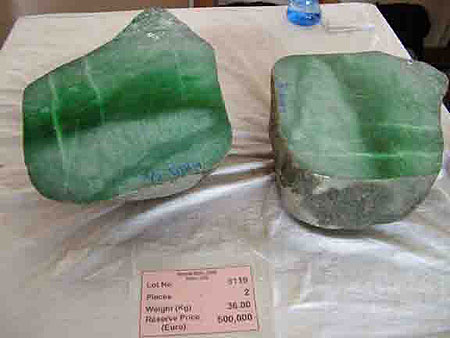 |
| Lots o’ lots. The reserve price for the jade boulder above was €500,000. Even though the AP story mentions only jade, gemstones also were on offer at the special sale in Yangon, as evidenced by the ruby crystals below. (Photos courtesy Kyaw Thu) |
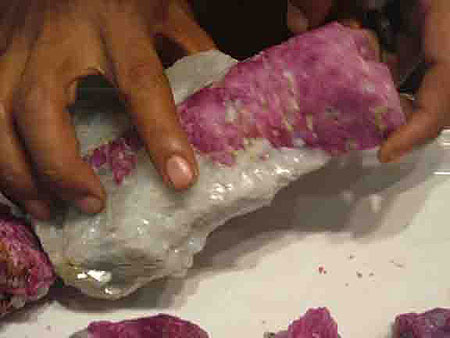 |
Xinhua News Agency reported July 7 that Burma gem merchants will participate in the seventh annual ASEAN gem show, July 10–18, at the International Gem Center in Kunming, the capital of Yunan Province. [back to top]
Burma’s Central Statistical Organization has released its production figures for fiscal year 2008–09, which show both gains (jade, ruby, sapphire) and losses (spinel, peridot, pearl, total gemstone output) against last year’s figures.
For the actual figures, see Pala’s Burma Gem Sales and Statistics. [back to top]
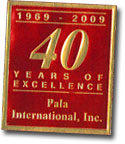 |
This month in Pala International Gem News we celebrate the 40th anniversary of the founding of Pala International. Thanks to everyone—clients, collectors, colleagues, and staff (past and present)—for helping to turn what was once a private passion into a truly international enterprise. We’re proud of our record, and just as pleased to be bringing you the features that follow…
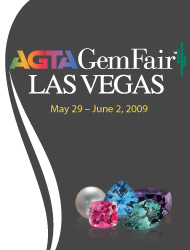 |
JCK featured two dozen articles on the recent show in Las Vegas. In coverage of a talk by Gemworld International’s Richard Drucker, JCK’s senior editor Paul Holewa wrote that the colored stone industry is stable on per-carat prices. Drucker also said that rare and fine gemstones are maintaining their value.
As we noted last month in our item on the Sinkankas Symposium devoted to spinel, this gemstone is the “new darling” of the industry because it is untreated, according to the article. (Just watch out for the synthetics…)
A panel on regulatory issues was covered by JCK’s senior editor Rob Bates. American Gem Trade Association executive director Douglas Hucker reiterated that the trade group feels the Burma ruby ban may be affecting small-time miners in a way that wasn’t intended by the legislation. Other topics covered on the panel were gemstone irradiation and cultured pearls. [back to top]
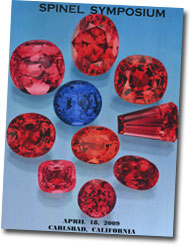 |
The handout for the seventh annual John Sinkankas Symposium, titled The John Sinkankas Spinel Symposium, was created especially for the event held on April 18, 2009. This center-stapled issue contains 52 pages of text plus 16 pages of full-color photos and is bound by a full-color cover including front, back, and insides. The handout contains:
Extra copies of this issue and the six handouts from previous symposia—including Quartz, Beryl, Tourmaline, Phenomenal Gems, Jade, and Garnet—are all for sale. The cost of the Spinel issue is $20 plus shipping, with discounts for multiple orders or complete sets.
[back to top]
This month we feature a mesmerizing sunstone from Tanzania. This unique variety of feldspar requires a closer look as flashes of spectral colors come firing out of the stone. Geometric platelets fill the inside of this jewel like confetti at a tickertape parade or looking into an active psychedelic snow globe.
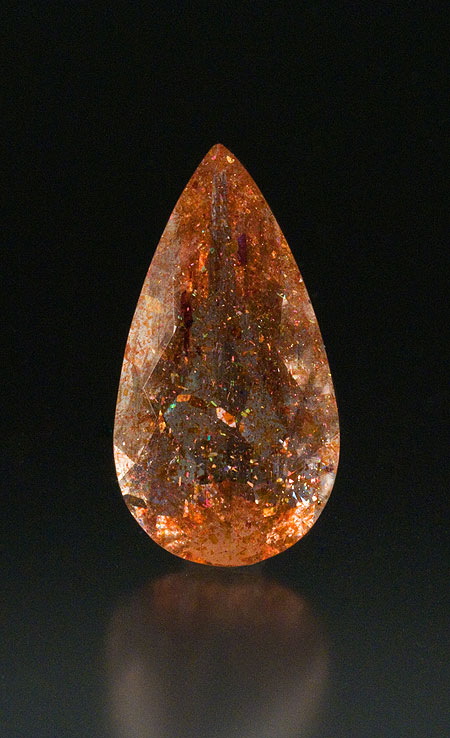 |
| Sunstone from Tanzania, Arusha Region, 20.37 carats, 29 x 15.3 x 8.9 mm. Inventory #17383. (Photo: Mia Dixon) |
These randomly oriented inclusions are hematite platelets, a product of exsolution, and exhibit a rainbow of interference colors as the light passes through at different angles. The hematite platelets display mainly a reddish orange hue, which gives this stone its warm body color. This beautiful gemstone would work well in a designer pendant or simply as a collector’s stone demonstrating these unusual internal characteristics.
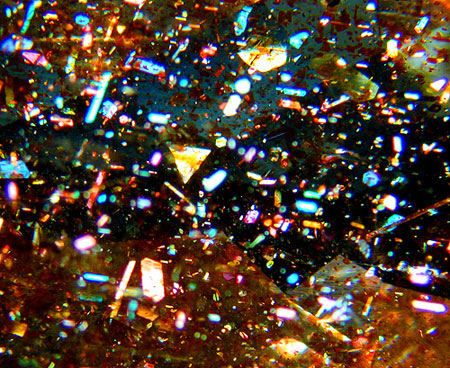 |
| Party colors. Photomicrograph showing the illuminated hematite platelets. (Photo: Jason Stephenson) |
Interested? Select Inventory #17383, call, or email us to inquire.
See also this February 2005 article, “On the Horizon: In search of East Africa’s eye-catching Maasai sunstone,” from Lapidary Journal Jewelry Artist. [back to top]
Pala International is pleased to have been selected by J. Richard Harris to offer The Harris Gemstone Collection, a 173-stone set assembled during travel to 85 countries. Pala offers the first two groups out of the recently acquired collection. From diamond, ruby, emerald, and sapphire, to brazilianite, diopside, and wulfenite, Harris amassed a collection fit for the connoisseur of precious stones and the inquisitive collector.
As Harris tells it, in an explanatory essay, “The unusual, even bizarre, variety of gemstones was collected to satisfy my life-long geological interest in all types of gems and minerals. It’s a collection for active study; not so much for static observation.”
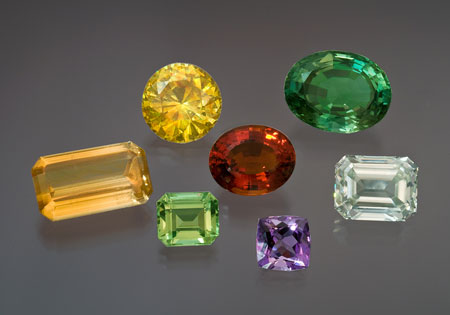 |
| From The Harris Gemstone Collection. A selection of seven of the 173 gemstones. (Photo: Mia Dixon) |
Shown above are the following selections from the collection, clockwise from left.
June 26, 2009 marks Pala International’s fortieth year as an enterprise—encompassing mining, wholesaling of colored gemstones, jewelry and lapidary design and sales, and, of course, fine mineral specimen offerings. Here are some of the highlights…
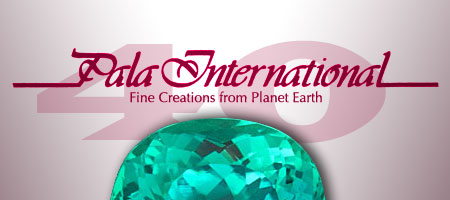 |
Read the full story here. [back to top]
Last month we looked at red feldspar in terms of locality and enhancement. This month we look at the material in terms of nomenclature and its relation to locality. Mineralogist and consultant John S. White, as we noted in December, has questioned the casual interchangeability of names. He suggested we dialogue with Dr. Joel Arem, who had briefly mentioned nomenclature in a Colored Stone article last fall. And we recalled that author and dealer Richard W. Wise had discussed the “name game” in another context (remember paraiba?).
Discussion of nomenclature, as with red feldspar, can come into play when scientific inquiry into a given material raises issues in the market. As Dr. Arem told us, “In science nomenclature is critical. But in the marketplace it appears not to be.”
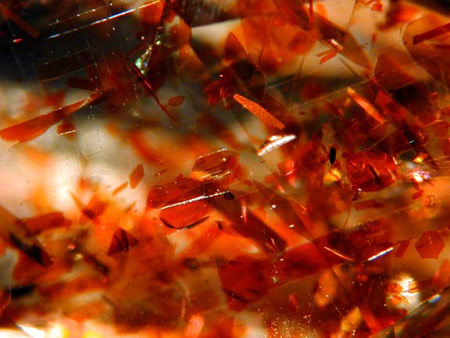 |
| Orange rush. This photomicrograph of another sunstone from Tanzania shows randomly oriented hematite platelets that exhibit interference colors under oblique illumination. This and more images of inclusions can be found in our gallery, “Internal World of Gemstones.” (Photo: Wimon Manorotkul) |
The scientific umbrella under which this material falls is plagioclase feldspar, consisting of six species—each delineated arbitrarily by its own narrow range on a full sodium-to-calcium ratio. But some material straddles those delineations. For instance, the red feldspar that became controversial two winters ago, ostensibly from Mongolia, crossed the line between andesine and labradorite (and actually was marketed as such, as well as being referred to as sunstone). In March, Gemological Institute of America Lab’s Shane McClure and Christopher M. Breeding issued a graph based on testing that shows fairly distinct locality-specific groupings on the Na:Ca scale for material that came from three deposits, including Mongolia. Material from Oregon, which has been marketed as sunstone, also straddled the line between labradorite and bytownite.
The third locality, Mexico’s Casa Grande mine, produced material that tested unambiguously as labradorite. Thus John White’s question: Why is Mexican labradorite being called andesine? “What’s the point of confusing an already confused public, as well as much of the trade…?” he asked in December. (We at Pala’s Gem News also used the term, as a short-hand for andesine-labradorite.) The laxity may stem in part from the fact that the three species can respond to diffusion enhancement in ways so similar that their scientific differences begin to fade.
But back up. The six-species model is passé. White:
To begin with, oligoclase, andesine, labradorite and bytownite are no longer regarded as species by the mineralogical community. They have been relegated to the status of non-species. All that remain are albite and anorthite of the plagioclase group, which should simplify this whole thing except for the fact that much of the disputed material from Asia falls right smack in the middle of the [revised] series, so technically some is albite and some is anorthite. But, as long as people continue to call it andesine, when some is not andesine (in terms of the definition of andesine, which is still meaningful even if andesine is obsolete), then I begin to rant. My only point is “stop calling it what it isn’t” and this is in the context of the old, but still widely used, plagioclase nomenclature.
Unfortunately, using today's nomenclature is still troublesome because the shift in chemistry from andesine to labradorite falls exactly in the middle of the plagioclase feldspar series, so if there is more calcium than sodium the proper name is anorthite and if there is more sodium than calcium the proper name is albite. But, as Arem has written, the variation in chemistry is often very subtle and so the distinction is not easily tested.
Well, when we proposed taking up this subject, we were told it might be met with glazed-over eyes. Arem:
The problem with making gem nomenclature homogeneous is that gemology is not a true science (I hear the moans and groans out there already). It is burdened with antiquated methodology, and a terminology base that goes back more than 3,000 years. Many of those “old” labels are still in use! And you have the “old guard” jewelry folks who grew up with the “comfortable” old terms and are reluctant to change, the laboratory types who insist on naming things “properly,” the consumers who are totally confused by it all—and nobody who is recognized as a final authority.
 |
| Gone green. Above: This 3.68-carat neon green feldspar from Vietnam is a cousin to sunstone feldspars. Inventory #12779. (Photo: Wimon Manorotkul) Below: Another, 2.40 carats. Great for a collector. Inventory #12778. (Photo: Mia Dixon) |
 |
And this leads to the question, What best serves the consumer? Richard Wise:
In one sense the use of the terms labradorite, sunstone, andesine, and so forth are confusing to the consumer and I am in favor of reducing confusion wherever it is found. We have many types of moonstone, but few complain that they may be very differing varieties. As I understand it, there is little by way of important gemological distinction to be made.
From purely a marketing standpoint, I like the term sunstone. I am sure, however, if you were to ask the folks at one of the mining operations in Oregon how important it is to distinguish native American sunstone from say andesine, they would say that it was very important.
Wise raised a point that White and Arem stressed: the sunstone moniker has applied to material from around the world. In addition to Mexico and Mongolia…
Arem opines that “if you use a term in the gemstone marketplace, and someone who hears it can get a ‘visual’ image of what you are talking about, the species, locality, cause of phenomenon, etc, etc simply do not seem to be important. Period.” But with the array as listed above, “sunstone” might not be all that useful.
So education would be in order. It could come from several sources. Arem tells us that his online Colored Stone article, “New Gemstone Treatments – A Coming Crisis”—the expanded and definitive version of the May–June 2009 print edition—is a step in that direction. Such information can be read (but more importantly referred to) by consumers, jewelers, dealers, and others who simply don’t read, say, Gems & Gemology. Disclosure of locality and scientific name when known (mindful of the “non-species” wrinkle), might be a spur to self-education (especially if authoritative resources, once located, are only a keyboard away). [back to top]
Last month we pointed almost parenthetically to Richard Wise’s discussion of diffusion (and more) on his GemWise blog. We received a rather urgent message from ISG’s Robert James, who asked us to point to his rebuttal. (Caveat lector: Contains emoticons. Sorry, we couldn’t resist…)
And, as mentioned above, note that Dr. Arem’s article in question has been expanded to its original, pre-print-publication length, and contains his own images. [back to top]
In Mixed Bag we look at a couple of unrelated topics…
Elise Skalwold, whose work on the “Viking compass” and “Usambara effect” we profiled this month in Pala’s Mineral News, sent us the following photo and note.
Just so you know what lengths people will go to to read your newsletter, here is Dr. Bill [Bassett] trying to read about hackmanite in your last edition on my Blackberry with the aid of a bit of magnification—he found it quite fascinating, as did I.
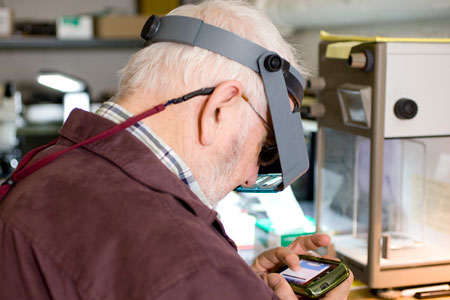 |
| Virtual reality. Cornell professor Bill Bassett uses a Blackberry and some magnification to view our featured stone for May, a 7.87-carat lavender hackmanite. (Photo: Laura Kozlowski) |
[back to top]
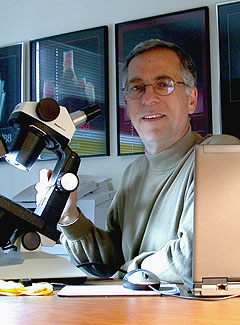 |
Gary Roskin, who most recently was a senior editor at JCK Magazine (for a dozen years), is launching The Roskin Gem News Report on the 4th of July. It is billed as a “free online subscription” written for “retail jewelers, consumers, jewelry and gem suppliers, gem artists, appraisers, consumer fashion industry leaders, and gem enthusiasts everywhere.” The Report will focus on “gemstone information vital for successful and ethical business, as well as for the pure pleasure of Mother Nature’s wonders.”
The website currently has placeholders for ten areas of interest, including Diamonds, Colored Gems, Pearls, Estate Jewels, and a Quiz of the Week. [back to top]
 |
| Wabi-sabi, the Japanese aesthetic, can have many connotations, including flawed beauty. We humbly offer this 17.15-carat moonstone from Burma, containing an eye-visible inclusion. Inventory #5318. (Photo: Wimon Manorotkul) |
A special gem sale opened yesterday, June 22, at the Myanmar Convention Center in Yangon, according to Xinhua News Agency. The sale will end on July 4.
Kurt Campbell, who is President Obama’s choice for Assistant Secretary of State for East Asia, has indicated the need for moving beyond sanctions, according to an AP report on his June 10 Senate confirmation hearing. Campbell’s statement is available here.
The Irrawaddy reported in its June 6 weekly business roundup on American Gem Trade Association’s lobbying efforts to reverse the Burma ruby ban. The efforts include a petition to Secretary of State Hillary Rodham Clinton signed by several other trade groups. See also this expanded June 1 report in National Jeweler. [back to top]
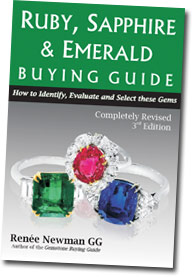 |
At the Vegas show, author Renée Newman ran into Pala’s Josh Hall and asked if we’d care to inform the readership of the third edition of her Ruby, Sapphire & Emerald Buying Guide. We’re delighted.
The guide—subtitled How to Identify, Evaluate and Select these Gems—is revised and expanded, with 173 new color photos, 16 new tables, and two new chapters: “Geographic Sources,” and “Appraisals versus lab reports.” The chapters on ruby and sapphire treatments and clarity grading are expanded.
Some highlights:
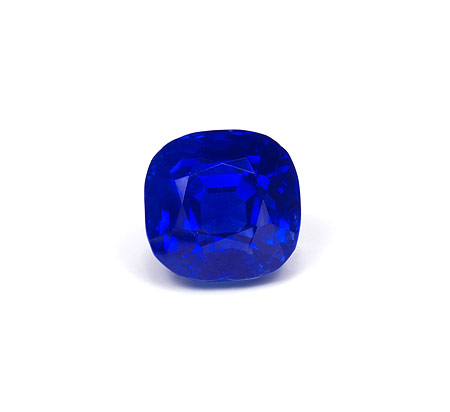 |
| This blue sapphire from Kashmir is featured in the new edition of Newman’s book. Its inclusions, known as silk, are characteristic of this natural gemstone. Pala’s Josh Hall tells us that with its perfect color and size, and velvety transparency, this is the nicest Kashmir he’s seen in ten years. (Gemstone: Josh and Jill Hall; Photo: Wimon Manorotkul) |
For more information, including an impressive group of reviews by key players in the industry, see the author’s website. The book is available from booksellers everywhere.
Following is an adaptation from the book, dealing with clarity grades.
Newman’s book has information on the new Gemological Institute of America (GIA) clarity grades and additional photos, diagrams, and data on the American Gemological Laboratories (AGL) clarity system in order to help trade members understand appraisals and lab reports. She believes that appraisers should indicate the clarity grading system used when assigning clarity grades because grading definitions vary from one system to another. For example, the term “moderately included” has different meanings.
GIA defines a “Moderately Included” sapphire as having noticeable inclusions apparent to the unaided eye. The AGL system, on the other hand, defines “Moderately Included” as having internal or surface characteristics that are noticeable under 2.5 magnification.
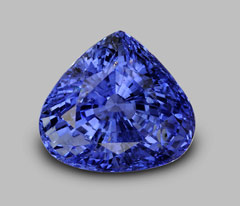 |
| An 11.60-carat sapphire with an AGL clarity grade of MI2 range (faint color zoning present) based on 2.5x magnification. (Sapphire courtesy of Ernie & Regina Goldberger; Photo: Chris Smith of AGL) |
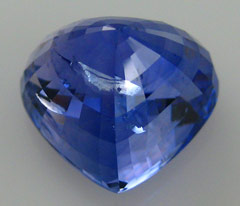 |
| The grade-setting inclusion is the fracture on the pavilion. Face-up this sapphire looks eye-clean in normal overhead lighting. Face-down the fracture is difficult to see with the unaided eye. (Photo: Renée Newman) |
Colored stones receive higher grades under the GIA system because GIA grades are assigned using the unaided eye, whereas AGL grades are based on 2.5x magnification and then verified with a microscope. The top grade in the new GIA clarity grading system is “Eye-clean.”
When appraising colored gems with an SI1 to IF diamond-type clarity, it’s best to use a clarity system that has grades higher than Eye-clean. Otherwise, an insurance company can legally replace the stone with one that is of lower clarity and lower value if the stone is lost or stolen. Clarity differences can play a significant role in the pricing of gem-quality rubies, sapphires, and emeralds. Therefore on lab reports, dealers generally want their top-clarity stones differentiated from those that are just eye-clean; it helps them sell the stone for more money. [back to top]
— End June Newsletter • Published 6/23/09 —
 |
It’s time for the JCK Las Vegas show. Pala International will be there in force, with one of America’s largest selections of fine colored gems.
Note: The show this year runs Saturday through Tuesday. The AGTA Pavilion still opens one day early—Friday, May 29—before the main JCK Show.
When: May 29–June 2, 2009
Where: Venetian Hotel Grand Ballroom adjacent to the Sands Expo & Convention Center, Las Vegas, NV
Hours: AGTA Gemstone Section
Friday, May 29: 10:00 AM - 6:00 PM
Saturday, May 30 to Monday, June 1:
9:30 AM - 6:00 PM
Tuesday, June 2: 9:30 AM to 4:00 PM
Booth: AGTA Pavilion, booth 34308
We look forward to seeing our many friends there. Visit the Pala International Show Schedule for future events. [back to top]
Pala International’s Bill Larson attends this event every year, held in the midst of the Alsace wine region of northeastern France.
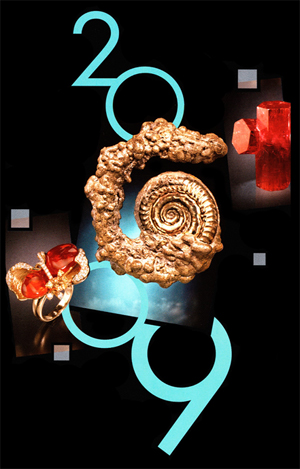 |
See Bill’s report from the 2008 show to get a taste. Fluorite specimens from Asia and Africa caught the eye last year, but it is the local variety that will take center stage this year, in l’Espace Prestige, housed in Sainte-Marie-aux-Mines’ local theatre.
Bill looks forward to seeing you there.
What: Euro-Mineral/Euro-Gem
When: June 25–28, 2009
Where: Sainte-Marie-aux-Mines, France
 |
| Fluorine française. This year shines the spotlight on fluorite from France. Our 14.22-carat continental charmer above is priced with an earlier exchange rate in mind… |
[back to top]
See information above about purchasing handouts from the John Sinkankas Symposia.
This year’s seventh annual John Sinkankas Symposium was all about spinels: from the complex optical world to the historic localities in the Himalayas, from the commercial applications of synthetic spinel to spinel from outer space.
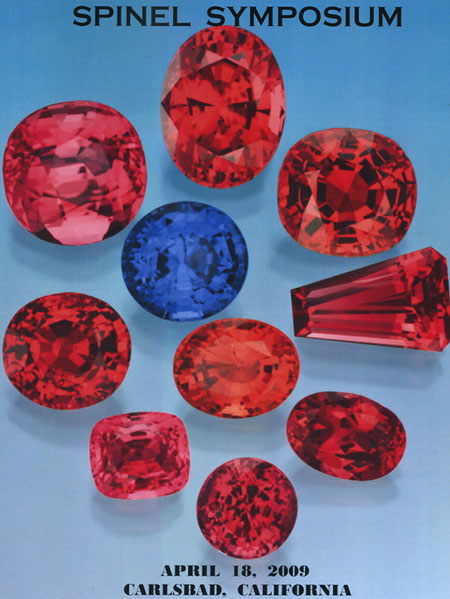 |
| The cover of this year’s program displays red and blue spinels. But there’s more…. |
The room was packed Saturday morning, April 18, at GIA, as teachers, gem dealers, gem collectors, scientists, gem cutters, and appraisers gathered to fill up on the plethora of information being dished out by ten of the industry’s leaders in the world of colored gemstones.
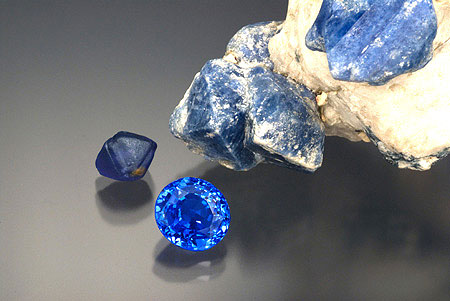 |
| Rough and cut, blue and red. Natural octahedral crystals with their faceted counterparts. The cobalt blue specimen above right is from Montana; the smaller crystal and cut stone are from Sri Lanka; all are from Bill Larson’s collection. The red spinels below are from Mogok, Burma, also from Bill Larson’s collection. (Photos: Wimon Manorotkul) |
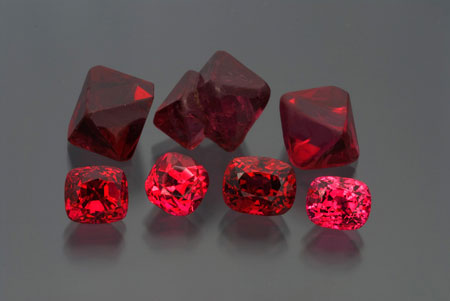 |
The following speakers spoke about spinels in their specialized disciplines: Si Frazier on the history and mystery, Edward Boehm on the curious lore and historic localities, and Skip Simmons on the mineralogy and crystallography. Jennifer Stone-Sundberg covered all the synthetic aspects, Jo Ellen Cole spoke on the market and values, and Bill Larson took us from mine to gemstone, focusing on the five major deposits. Meg Berry showed us some cutting techniques, Bob Weldon honed in on some photography skills, John Koivula took us inside the gem, and George Rossman discussed color agents.
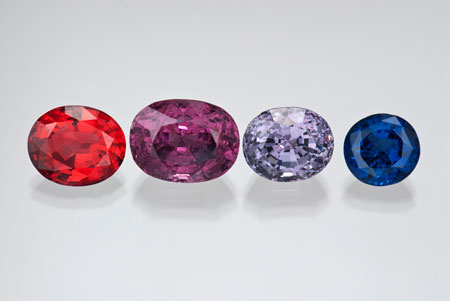 |
| A suite of multicolor spinel from the Dr. Eduard J. Gübelin gem collection, which was recently acquired by GIA. (Photo: Robert Weldon) |
Interest and perception of spinel has grown rapidly in recent years as the “natural” factor becomes more important to the consumer. (A case in point: out of 207 spinels offered on Palagems.com, 206 are unenhanced.) The enthusiasm at the symposium was very apparent as all the spinel lovers got the full spectrum of information. Spinel has grown in value, as the perception of spinels as a rare and precious gemstone has expanded.
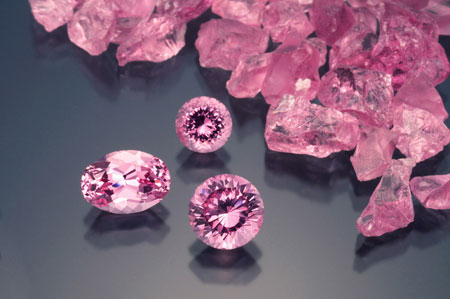 |
| Natural rough and cut material from a new find in Tajikistan, one of the oldest localities known to produce spinel. (Photo: Wimon Manorotkul) |
Something not included at the symposium, and which we are pleased to feature here, is the following poem, set near Ratnapura, Sri Lanka, by one of the ten presenters…
A Spinel is Found in the Kalu Ganga
Along the river’s very edge,
A cobra gleams in dappled light.
And on the other side,
I watch men dredge
And pull the mud with all their might.
The snake’s indifferent to their labor,
For him another kind of prey.
It’s a frog that he will savor
To finish off his day.
In Kalu Ganga’s brackish stream
Are gems concealed in soil.
To find one is, for men, a dream,
A chance to rest from toil.
A man in loincloth pans and sluices,
And shortly there’s a cry
Extracted from the river’s juices,
A gem he’s holding high.
The new spinel is rubbed and cleaned,
The polisher’s wheel will find,
Soon to be prepared and preened
In a golden jewel enshrined.
I look to see… the snake is gone;
It found what it had sought.
Today is good for everyone,
A spinel to us is brought.
— Robert Weldon
A phenomenal variety of sodalite and a member of the feldspathoid group, hackmanite is mostly found in a translucent cabochon form. This month we feature a transparent faceted hackmanite from Afghanistan. This gem is near-flawless and exhibits all the unusual optical characteristics associated with hackmanite.
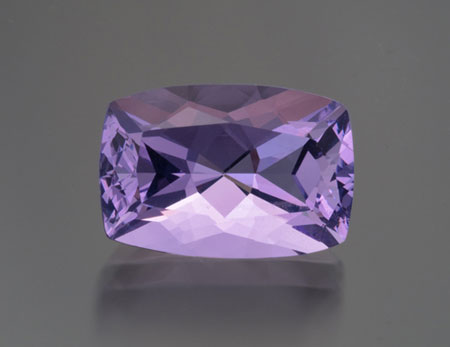 |
| Lavender hackmanite from Afghanistan, 7.87 carats, 16.28 x 11.08 x 8.64 mm. Inventory #17382. (Photo: Mia Dixon) |
Hackmanite is known for its unique color-shift phenomenon when subjected to warm white light or daylight. The phenomenon is known as tenebrescence. Hackmanite will often increase in saturation when allowed to be “charged up” in daylight and sometimes shifts between lavender and magenta hues. Long-wave ultraviolet light also brings out an amazing fluorescence, as seen directly below; in this case we see a glowing orange/yellow hue. The distinctive color phenomena are derived from the sulphur component in hackmanite’s chemistry. Light can polymerize the sulphur into different-length molecules and ions that, in turn, have different colors. (Thanks to Dr. George R. Rossman for clarification of the color phenomena science. See this Caltech webpage for more on the sodalite group.)
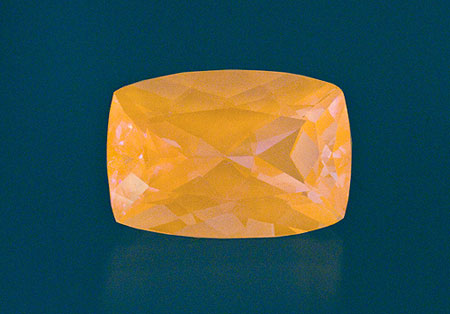 |
| Long-wave ultraviolet light shows off the fluorescence of this hackmanite. (Photo: Mia Dixon) |
An amazing feature that is illuminated by the unusual optics of this stone is seen when a beam of long-wave UV light is shot through the table. You can actually see the refraction of light as it travels though the stone: entering the table, bouncing off the pavilion, and traveling back out the table. A living example of all the diagrams you’ve seen drawn with stick figures in gem books. Like a laser through smoke the path of light is captured by the internal structure of the gem, and highlighted by the facets and form of this hackmanite.
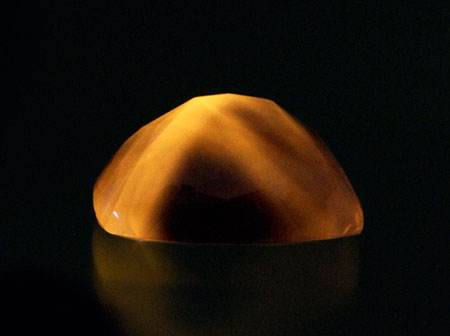 |
| A beam of long-wave ultraviolet light demonstrates the refraction path. (Photo: Mia Dixon) |
Interested? Select Inventory #17382, call, or email us to inquire. [back to top]
Ah, the month of May….
The time of year when amazing tones of green manifest themselves in all parts of nature with a true sense of renewal.
It’s for this reason that the stone you’ll see in this installment of Private Eyes can be nothing else but Emerald. Read more…
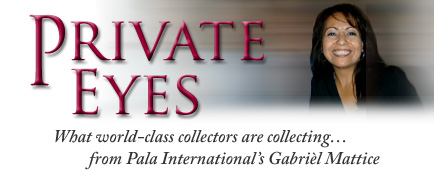 |
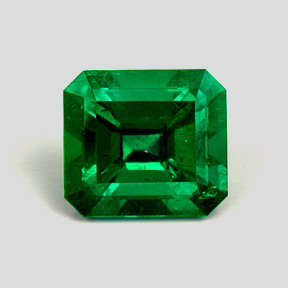 |
| When one considers the addition of an emerald to their collection, the source from where it comes is always a factor and Colombia is most always the origin of choice. At 8+ carats, this oil-free, enhancement-free emerald is truly rare to behold. (Photo: Wimon Manorotkul) |
[back to top]
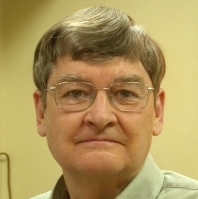 |
On March 13, Caltech’s Dr. George R. Rossman presented long-awaited findings on his and his team’s research into the science surrounding Chinese red andesine feldspar. The material—marketed by Jewelry Television during the winter of 2007–08 to the point of exhaustion—came under scrutiny as interested parties followed up on rumors of heat treatment, copper diffusion, and non-existent localities.
Dr. Rossman, who is professor of mineralogy at Caltech’s Division of Geological and Planetary Sciences, delivered the findings to a meeting of the Mineralogical Society of Southern California, in a talk entitled “Oregon Sunstone and the Chinese Red Feldspar Controversy.” (See minutes of the meeting.) He began by discussing material from localities (and possible pseudo-localities) as diverse as Oregon, northern Mexico, the Congo, the China–Mongolia border, and Tibet. Red material, from whatever source, had historically been considered rare, and so the quantities seen in the market two years ago raised a red flag.
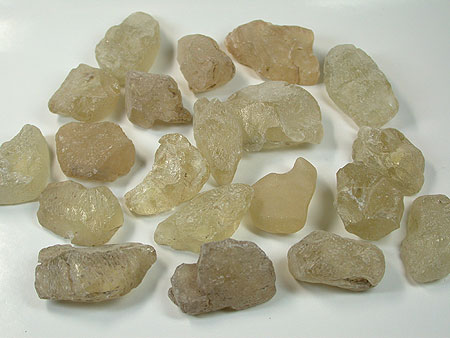 |
| China white. A group of rough feldspar from the China–Mongolia border locality. (Photo: George R. Rossman, California Institute of Technology) |
Suspecting Chinese feldspar might have obtained its color via heat treatment, Dr. Rossman and his Caltech team used high-temperature ovens on such material, but weren’t successful in achieving the red color. Claims that the material might have been shipped from North America and treated in China were curbed by using locality-fingerprinting analysis.
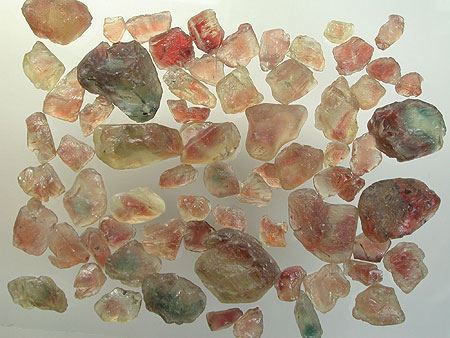 |
| Variations on a theme. Another batch of rough feldspar, exhibiting the kind of color that has been reported for Tibetan material, but which was in fact given to Dr. Rossman as having come from the China–Mongolia locality. (Photo: George R. Rossman, California Institute of Technology) |
The team successfully demonstrated the ability of copper to diffuse into feldspar. (Dr. John Emmett, of Crystal Chemistry, also had success at such diffusion, as reported by JCK’s Gary Roskin last November.) The group then proved that Chinese feldspar was “devoid of radioactively generated argon,” an element that is expected—except in the case of subjection to high temperature, which is typically required for diffusion. So is this the test for enhancement? “Yes…,” Dr. Rossman told us, “but at what cost? The expense of such tests is very large and it is totally destructive.”
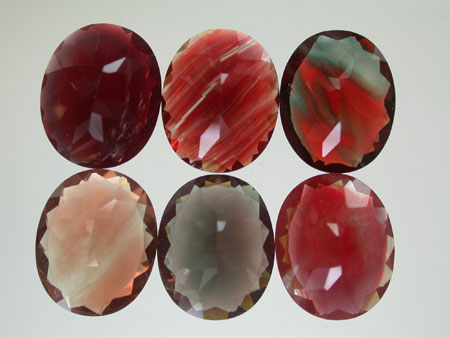 |
| Turned tables. A sample of faceted (and treated) Chinese feldspars, shown table-down. The stripes and swirls, while sometimes seen in material from Oregon, are more common in treated stones from China–Mongolia. (Photo: George R. Rossman, California Institute of Technology) |
Other isotopic comparisons by Dr. Rossman and team, coupled with chemical analysis, revealed the Tibetan material to be virtually indistinguishable from the Chinese. Considering the distance between the localities, such similarity was unexpected by the team, and further testing of additional samples is underway. In April, Dr. Rossman received new samples that were personally collected at both localities by Dr. Ahmadjan Abduriyim, of the GAAJ-Zenhokyo Laboratory, who visited the mines last fall. Because testing on the samples is not yet complete, Dr. Rossman told us, “I withhold judgment.”
Even if the testing of the Tibetan material were to confirm natural red color, as well as chemical differentiation between it and Chinese material, obtaining an inexpensive and non-destructive method of enhancement testing will remain a challenge. [back to top]
John S. White, who has his own bone to pick regarding andesine-vs.-labradorite nomenclature (last touched on in our December edition, and which we hope to address in a future issue), pointed us to Tuesday’s post on Richard W. Wise’s GemWise blog, regarding the diffusion issues raging in the minds of many a gemologist: “Grain Boundary Diffusion in Tourmaline; The Epochal Crisis, Part II; A Tempest in a Tabloid.” Not for the faint of heart… [back to top]
In Mixed Bag we look at a couple of curiosities…
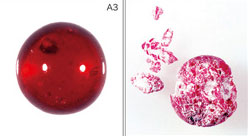 |
| Oops. For heavily filled rubies, you might want to avoid immersion in hydrofluoric acid. (Photos courtesy GAAJ) |
Ever tried to clean that nasty lead-glass filling from your favorite enhanced rubies? Well, Gemmological Association of All Japan’s Dr. Jun Kawano shows some of the do’s and don’ts.
Seriously, a March 25 lab report looks at rubies with three degrees of filling (determination being done in a variety of ways). The three groups were then subjected to pickling solution and hydrofluoric acid—and some polishing. [back to top]
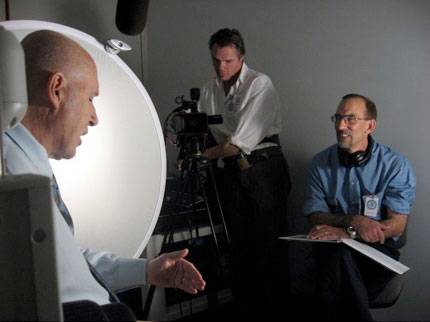 |
| GIA’s John Koivula, left, is interviewed by the Science Channel crew. (Photo courtesy Steven Ty/Science Channel) |
Here are details from a Gemological Institute of America press release:
John Koivula, GIA’s chief gemologist and an expert on extraterrestrial and terrestrial gems, helps explain the true nature of the mysteries held in the meteorite on the show.
The fragments in question, according to Koivula, are from a rare stony-iron meteorite known as a pallasite, which contains glassy-looking crystalline fragments of transparent to translucent olivine. These were captured as inclusions in a massive network of two solid elemental metals, nickel and iron.
“Since olivine occurs much more commonly on Earth and is known by its gem name, peridot, it is both commercially and scientifically important to be able to separate terrestrial olivine found on Earth from extraterrestrial olivine found in pallasitic meteorites,” Koivula said. “In fact, peridot or olivine extracted from pallasitic meteorites is the only matter from outer space that can, and has been, cut and used as a gem—and knowing the difference is where GIA gets involved.”
See the Meteorite Men website for broadcast dates and times. [back to top]
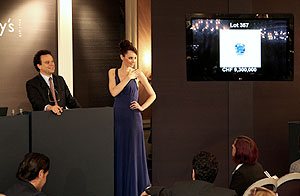 |
| (Photo courtesy Sotheby’s press release) |
A rare blue diamond sold May 12 for $9.5 million. It set two records: price per carat for any stone sold at auction, and price for a fancy vivid blue diamond sold at auction. The diamond realized $1 million above its pre-sale estimate.
The 7.03-carat diamond was unearthed—literally—just last year at Petra Diamonds’ Cullinan Mine. The stone’s sale was held by Sotheby’s Geneva (see BBC video). Its buyer—who initially remained anonymous—is Joseph Lau Luen-Hung, a Hong Kong collector, according to Petra. He exercised his right to name the stone: Star of Josephine.
The price was bid up between Lau Luen-Hung and a second remote caller. The competition and high value for this blue diamond exhibit how rare and valuable collectors hold these one-of-a-kind type items. The rarest-of-the-rare always seem to hold and increase their value as Earth’s hard assets. [back to top]
 |
Russia’s state-owned diamond company, Alrosa, this year quietly surpassed De Beers as the world’s largest diamond producer but hasn’t sold a rough stone on the open market since December, according to a May 11 New York Times article.
It’s no secret that the price of diamonds has been linked to the careful maintenance of supply. For years, De Beers had that role, but in 2006 the EU ordered the company to open the market to more competition, banning it from buying rough diamonds from Alrosa as of this year. Meanwhile Alrosa has taken its own leadership role. One example of several from the Times article is Alrosa’s persuasion of Angola’s central bank to buy a percentage of that country’s production, thereby keeping those diamonds off the market. While De Beers has closed mines following the EU order, Alrosa has worried about the social repercussions that unemployment might provoke, and thus has resorted to stockpiling as well as the other maneuvers outlined in the Times article.
See an April 22 interview with Alrosa president Sergey A. Vybornov here. [back to top]
 |
| Southeast coast of Greenland, across the tip of the landmass from the new rubyland. (Photo: Wikipedia) |
Since 2004, Vancouver-based True North Gems has been developing a deposit of gem-quality rubies in southwestern Greenland. But more recently Inuit ruby hunters have initiated a sort of geological civil disobedience by surface mining within the area licensed to True North by Greenland’s Home Rule government.
The issues of rights—mineral, aboriginal, and governmental—in a land that has no private property, are discussed in a May 17 report by The Canadian Press (no longer available). See this April 16 report on The Epoch Times. [back to top]
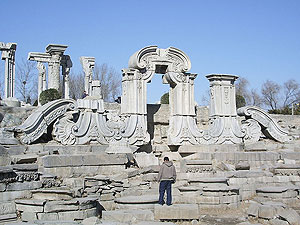 |
| The Summer Palace complex contained a few European-style buildings, commissioned by the Qianlong Emperor in the 18th century. (Photo: Clee7903, Wikipedia) |
A Qing Dynasty imperial seal sold in Paris on April 29 for €1.68 million ($2.23 million), according to Xinhua News Agency. “The relic had belonged to Elie Jean de Vassoigne, a French commander in China during the Second Opium War in 1860 when British and French forces looted the Summer Palace, the former home of China’s Qing Dynasty emperors.”
Chinese officials expressed “indignation” at the sale, as reported by AFP, but Thierry Portier, in charge of the sale, countered that Vassoigne was 200 miles away at the time of the Summer Palace pillage. The seal may be heading back to Asia, if not to China, as it was purchased by an unidentified Asian man. The sale is remarkable also because the final sale price was five times the estimate by the French auctioneer Beaussant Lefèvre (see also the photos there).
Last fall, a Qianlong Yubi seal, carved from stunning snow-white jade, sold for about $8.16 million at Sotheby’s—during the height of the economic crisis’s uncertainty. [back to top]
 |
| Moody. This natural 3.34-carat deep flaming red spinel from Burma could be just the thing to smolder during this summer’s extended twilights. Inventory #14845. |
Pala International’s Bill Larson just returned from Asia, and told us “I have very little to report. Bangkok was slow for business; every one is waiting for the turnaround.” (A May 18 Bangkok Post article discusses how Burma businesses are taking advantage of a porous border and migrant workers: they’re setting up shop in Thailand to avoid the “Made in Burma” label that isn’t sanctions-friendly.)
Regarding Thailand’s western neighbor, “Burma is seeing very little production,” Larson told us, meaning little of interest to his keen eye. “Frankly, their economic situation has been in recession for years, so the downturn did not change their economy much.” [back to top]
 |
| Joan Baez was featured in a FPB benefit on May 1. (Photo: Pat Swayne) |
A year ago, we directed readers to NGOs providing on-the-ground hurricane relief. Here’s a partial report of what was accomplished with your contributions.
On May 1, UNICEF issued an assessment of what was accomplished (focusing, of course, on child-related relief) and what yet remains to be done. A somewhat upbeat assessment was reported by Xinhua News Group of the Tripartite Core Group (Burma, UN, ASEAN) efforts, under the Post-Nargis Response and Preparedness Plan (PONREPP). [back to top]
 |
| Trilling! Peridot production in Burma is one industry sector that is soaring, and has occasionally yielded carat weights in the triple digits, as exemplified by this 100.15-carat natural (and terrestrial) trillion. Inventory #16980. |
[back to top]
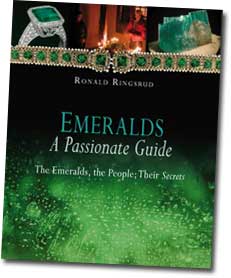 |
| The book cover’s main photomicrograph above shows a pseudo–gota de aceite effect (see Fig. 9 in the sample chapter). |
In February we dropped the hint that prominent emerald dealer Ronald Ringsrud had a book in the works. Emeralds, A Passionate Guide, subtitled “The Emeralds, the People, their Secrets,” made its debut at the 13th International Colored Gemstone Association Congress in Panyu, China two weeks ago. Congress attendees snapped up all the copies Ringsrud had in tow, but the book is now available for online order in two editions.
The book, which includes an introduction by John Koivula, contains 20 chapters covering lore, history, science, sources, recollections, and plenty of the subtle information Pala’s Gem News readers may recall from Ringsrud’s discussion of gota de aceite (or “butterfly effect”), which is in fact contained in this Web adaptation of a sample chapter.
As the book’s subtitle suggests, Ringsrud is passionate not only for the stones themselves, but also for the people involved; thus, a chapter is devoted to “Fair Trade Gems & Ethical Emeralds.” Likewise he is generous in imparting secrets of the trade for both connoisseurs and beginners, in chapters devoted to enhancements, “secrets,” and a buying guide.
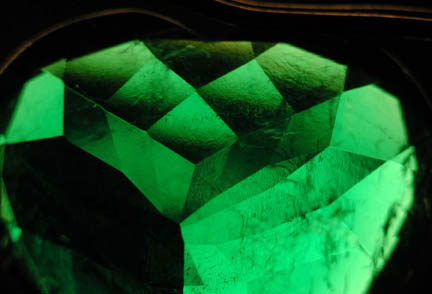 |
| Budding beauty. Like a blossom at the brink of bursting, this 9.2-carat gemstone (Fig. 1 in the sample chapter) displays in its upper facets the roiling cognac-in-water effect so prized by devotees of fine emeralds. (Photo: Ronald Ringsrud) |
Ringsrud, whose second home is in Bogotá, spent time in Colombia after college (as mentioned in a recent profile in Southern Jewelry News, archived here). But it wasn’t until he’d returned to Los Angeles, had by chance gotten a job at GIA (as a warehouse box mover!), and studied gemology himself, that he learned Colombia was home to the finest emeralds in the world. Click! Ringsrud visited the emerald land; possessing an unassuming nature, and being fairly fluent in Spanish, he was able put the local folk at ease, crafting lasting relationships that would allow him eventually to offer world-class emeralds to the most discriminating collector. (Here’s what political pundit Montgomery Chitty had to say about Ringsrud: “Rather like the way that American Indians had a wary respect for some of the craziest white settlers whose actions demonstrated a wildness akin to their own, the Colombians in the emerald mining region of Colombia have developed a respect for Ron.”)
Ringsrud has been publishing on the subject of emeralds for 25 years, in Gems & Gemology, Lapidary Journal, and other publications here and abroad. Emeralds, A Passionate Guide, is his first book—and a welcome one. [back to top]
— End May Newsletter • Published 5/21/09 —
2015.3 | 2015.2 | 2015.1
2014.3 | 2014.2 | 2014.1 | 2013.3 | 2013.2 | 2013.1 | 2012.3 | 2012.2 | 2012.1
2011.3 | 2011.2 | 2011.1 | 2010.3 | 2010.2 | 2010.1 | 2009.3 | 2009.2 | 2009.1
2008.3 | 2008.2 | 2008.1 | 2007.3 | 2007.2 | 2007.1 | 2006.3 | 2006.2 | 2006.1
2005 | 2004 | 2003 | 2002 | 2001 | 2000
Note: Palagems.com selects much of its material in the interest of fostering a stimulating discourse on the topics of gems, gemology, and the gemstone industry. Therefore the opinions expressed here are not necessarily those held by the proprietors of Palagems.com. We welcome your feedback.